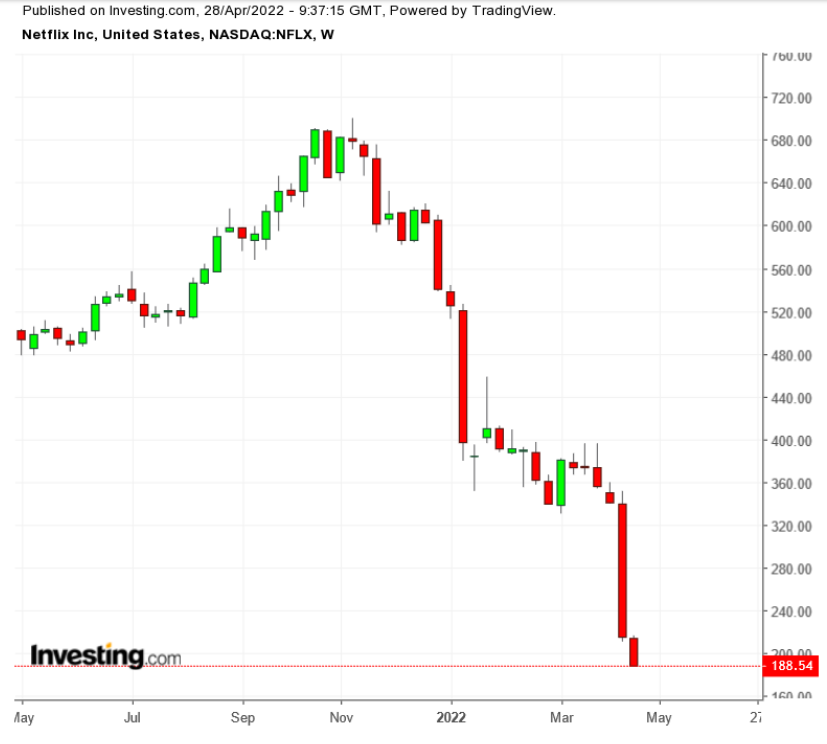United Homes Group stock plunges after Nikki Haley, directors resign
It's difficult to value streaming entertainment giant Netflix (NASDAQ:NFLX) stock with any real confidence. There are simply too many moving parts.

The novel coronavirus pandemic unquestionably pulled demand forward in 2020 and 2021, while also boosting viewership during those years. Now, in 2022, however, subscribers declined in the first quarter, and Netflix projects another drop in Q2. It's hard to tell if those results signal the end of the company's growth—or simply an unsurprising short-term headwind after nearly two full years of roaring demand.
The competitive environment has changed markedly. Three years ago, Netflix had no real competition at scale. Since then, seemingly every major media company has rushed into the space. Some will be real rivals for years to come, others will spend billions with little to show for it. Here, too, it's a tall task trying to gauge exactly what the longer-term picture looks like.
Fundamental analysis has its own core problem. Based on earnings, NFLX stock looks cheap. Using free cash flow, however, the stock looks remarkably expensive. Which valuation an investor uses, in turn, is driven by their opinion of the business.
Investors are, thus, left trying to use some common-sense methods to understand whether Netflix stock has fallen far enough. Unfortunately, it doesn't look like it has.
Netflix Versus ESPN
In the late 2010s, Netflix probably was the best entertainment business around. Certainly, it seemed to be valued as such. In 2018, the company became the most valuable media company in the world.
At that time, Netflix surpassed Disney (NYSE:DIS) to claim the title. One reason this happened is that ESPN, a Disney unit, was struggling. ESPN's trajectory then looks like that of Netflix now.
A few years earlier, ESPN had been one of the best entertainment businesses ever. In 2014, for instance, the company generated estimated fees of $6 per month per cable and satellite subscriber—which at the time in America was pretty much everyone. ESPN, thus, was getting in the range of $100 per year from almost every household in the country—whether that household watched ESPN or not.
On top of those affiliate fees came advertising revenue. And while ESPN paid handsomely for media rights, there was plenty of profit left over. In FY15 (ending September), Disney’s Media Networks segment generated about $8 billion in EBITDA (earnings before interest, taxes, depreciation, and amortization). To put that into context, HBO, a high-quality business then owned by Time Warner, earned only about one-quarter as much.
ESPN, no doubt, drove the lion’s share of Disney's Media Network profit, as other properties, like the Disney Network, ABC, and ABC Family, were far less impactful. In 2014, one analyst estimated ESPN’s EBITDA at about $4.5 billion—and ESPN’s standalone value at $50 billion.
Cord-cutting—which led to a reduction in cable and satellite subscriptions—has pressured ESPN’s profits and valuation since, to the point that ESPN remains a clear problem for DIS stock. But peak ESPN figures from 2014 provide an interesting heuristic for Netflix stock. Even with a sharp sell-off in NFLX stock since earnings, Netflix, at the moment, has an enterprise value just shy of $100 billion.
That, in turn, creates an interesting question: Should Netflix be worth more than 2x peak ESPN?
It’s difficult to make that case.
The Problem With Netflix Stock
It’s true that Netflix has a far larger international base (about 54% of CY21 revenue) and a much bigger growth opportunity overseas. But profit margins outside the U.S. are structurally lower; witness Netflix actually cutting prices in India, the world's second most populous country, late last year.
Indeed, in FY15, Disney's Media Networks segment had an EBITDA margin just shy of 35%. For Netflix, over the past four quarters, the figure is under 23%. Netflix is a less mature business, and still spending significantly on marketing, but even a mature Netflix probably isn't quite as profitable as peak ESPN. And again, the Netflix business is currently valued at roughly double what ESPN was.
It's possible to argue, perhaps, that Netflix's U.S. business (which generates higher per-subscriber revenue) is a bit more valuable than ESPN's was, while its international business can double that valuation. But even that only gets us to about where NFLX stock trades now.
Valuing Netflix on this single comparison admittedly isn't perfect, or precise. Still, no valuation method is, because of how hectic the last two years have been, and because of a key question surrounding Netflix's reported results.
Accounting And NFLX Stock
Looking at earnings, NFLX’s valuation looks reasonable, at ~19x trailing 12-month GAAP earnings and ~13x EBITDA (where depreciation focuses solely on property, equipment and intangibles).
Free cash flow tells a very different story, however. Netflix has historically burned cash, including in both 2021 and the first quarter of this year. A nearly $100 billion valuation for a cash-burning business seems close to ludicrous.
It's accounting that drives the divergence between earnings and free cash flow. In the profit and loss statement, Netflix amortizes the content over a period of years (usually within four years on an accelerated basis; see p.45 of the company's Form 10-K). In the cash flow statement, Netflix accounts for the actual cash spent on content during that period.
When content spend is growing, the cash flow statement will show higher content costs than the income statement. Amortization includes only a portion of current-period spend plus some modest residuals from cash spent in previous years. But as long as cash expense is higher in the current period than it was previously, the actual cash spent for content will exceed the amortized figure.
In 2021, for instance, cash costs were $5.5 billion higher than amortization expense. The gap was lower in 2020, but only because Netflix's cash spend plunged amid the pandemic. (The difference did narrow somewhat in Q1 2022, to $418 million vs. $565 million the year before.)
That accounting treatment on the income statement is based on a reasonable idea: that new content has some tail value to subscribers, tail value that fades over a span of few years. And so some—but only some—of that cost should be expensed in future years.
In theory, amortized costs at some point will be higher than, or at least in line with, cash costs—and at that point, Netflix (again, in theory) would become a cash-generating machine. But that requires that the growth in content spending slows substantially at some point. That hasn't happened yet, which is why Netflix is posting earnings on an accounting basis, but with the exception of 2020 (when, again, cash costs fell sharply due to external factors), it isn't generating positive free cash flow.
The Q1 decline in subscribers and guidance for a repeat performance in Q2 suggest that Netflix might have to keep increasing spending simply to keep its subscriber base reasonably intact. The fundamental problem in that scenario is that 'true' content spending is closer to actual cash spent.
That, in turn, means valuation has to hew closer to free-cash-flow-based methods rather than income-based methods.
From that perspective, the news looks even worse for NFLX than it does in the ESPN comparison. A company valued at nearly $100 billion that can't generate free cash flow certainly isn't a buy. If anything, it's a short.
However, there are a lot of moving parts here. Netflix has some levers to pull in order to reduce spending and improving profits and free cash flow.
Still, if the last two quarters are anything like what Netflix would look like in a more normalized environment, a $100 billion valuation is not going to hold—and shares of Netflix are going to keep falling.
